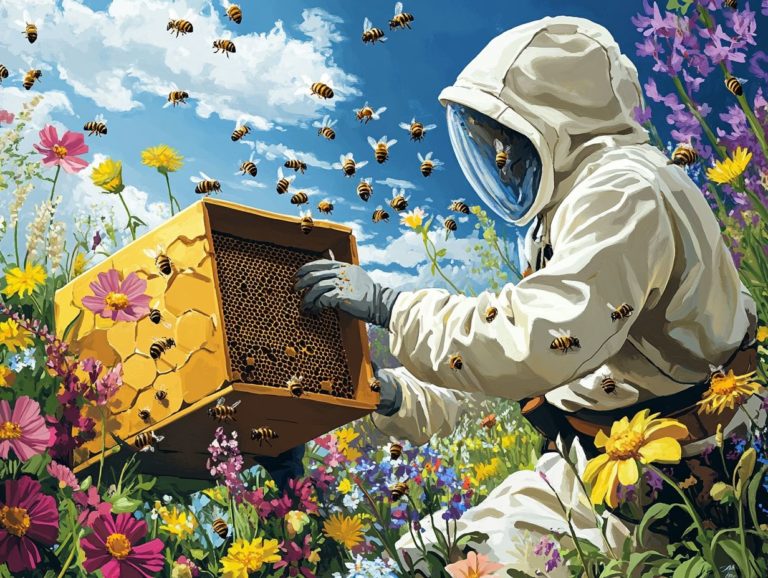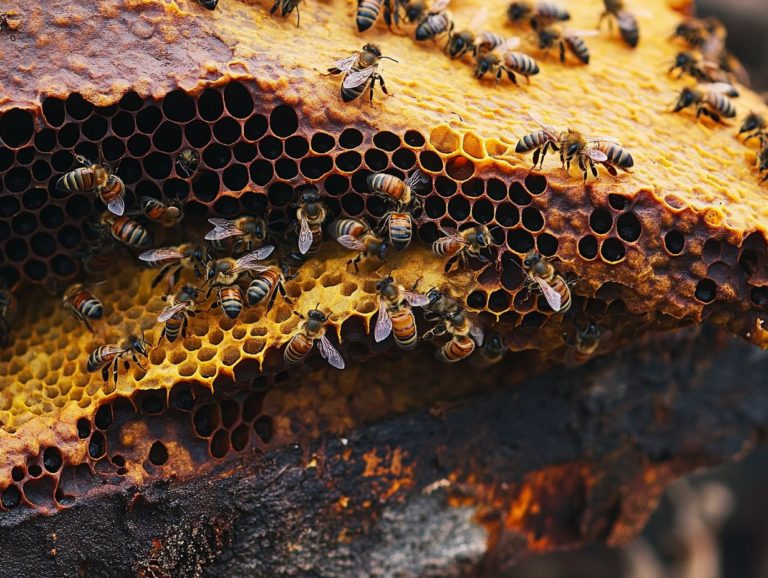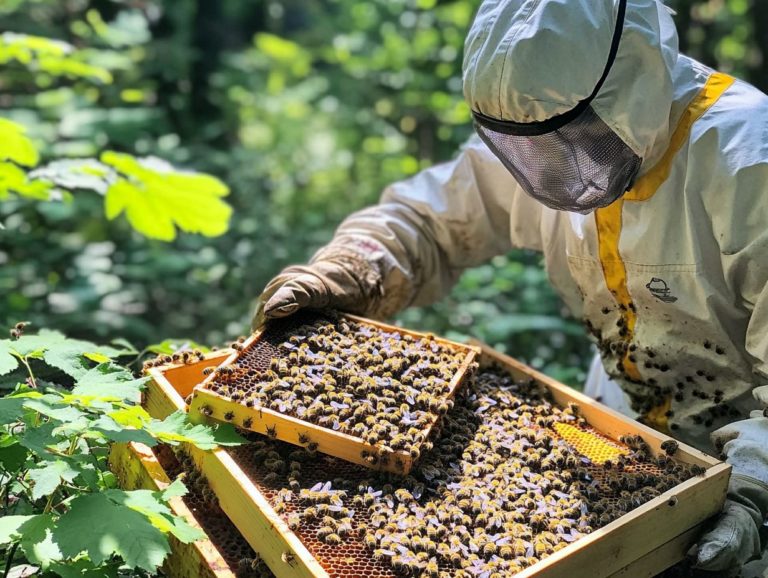How to Manage Nectar Flow in Hives
Nectar flow is an essential part of successful beekeeping, impacting both honey production and the overall health of your colonies. By understanding what nectar flow entails and why it is crucial, you can optimize your hives for maximum productivity and ensure robust colony strength.
Several factors significantly influence nectar flow, such as weather patterns, geographical location, and the availability of flowering plants. Get ready to discover effective methods for monitoring and managing nectar flow! This guide provides practical strategies to ensure your bees thrive, even in less than ideal conditions, including during nectar dearth periods.
Whether you are a seasoned apiarist or an eager newcomer, you will discover valuable insights that can elevate your beekeeping practices to the next level like managing swarm behavior and queen rearing.
Contents
Key Takeaways:
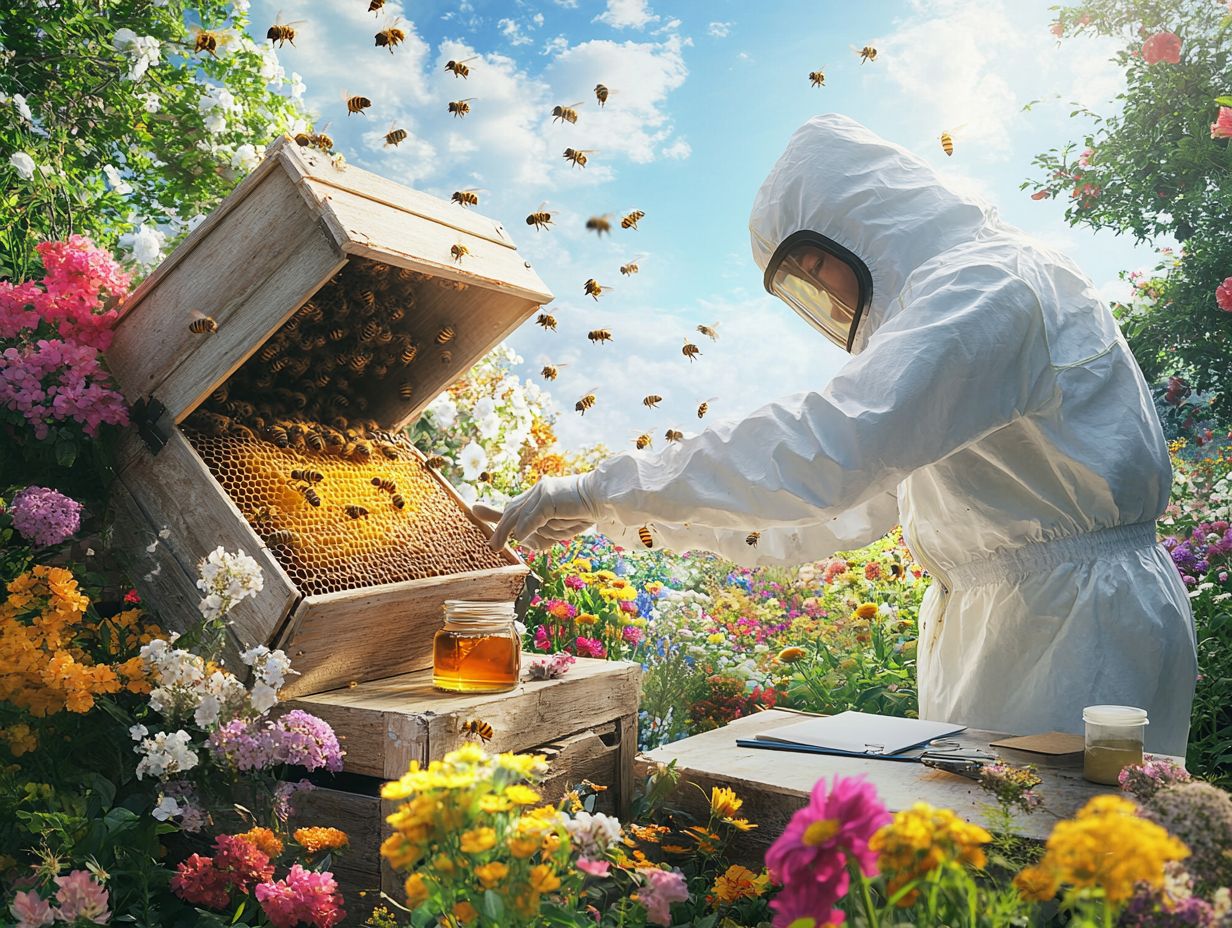
- Monitor nectar flow through visual inspections, refractometer readings, and weighing the hive.
- Manage nectar flow by providing adequate space, ventilation, and rotating supers.
- If nectar flow is low, supplement with sugar syrup, pollen patties, or consider moving the hive to a different location. Additionally, implementing pest management strategies can help maintain colony health during low nectar periods.
What is Nectar Flow?
Nectar flow pertains to the seasonal rhythm of nectar produced by flowering plants, which is vital for honey bees as it directly impacts their foraging habits and the overall vitality of their colonies.
During this cycle, foraging bees diligently gather nectar and transport it back to the hive. Here, it undergoes transformation into honey a critical component of the honey production process.
Understanding the intricacies of nectar flow is essential for you as a beekeeper. This knowledge enables you to manage your hives with precision and ensure that there are sufficient food reserves for brood rearing, the development of resilient winter bees, and successful egg-laying by the queen.
Why is Nectar Flow Important for Beekeeping?
Nectar flow is crucial in beekeeping, directly impacting honey production, colony health, and the long-term sustainability of bee populations. A robust nectar flow enables bees to gather ample food stores, essential for nurturing brood, ensuring the survival of the colony during winter, and supporting honey storage for future use.
As a beekeeper, you must closely monitor nectar flow patterns to improve how you manage your hives. This vigilance helps you maintain strong, healthy colonies that can thrive amid seasonal fluctuations, ensuring a stable adult worker population.
What Factors Affect Nectar Flow?
Numerous factors influence nectar flow, including weather conditions, geographical location, and the availability of flowering plants. Together, these elements determine how effectively honey bees forage and collect nectar.
By understanding these variables, you can enhance honey production and ensure the health of your colonies. Weather, for instance, plays a pivotal role in the secretion of nectar by plants. Specific locations may provide a rich array of floral resources, affecting nectar abundance and availability.
The types and quantities of flowering plants you cultivate significantly impact the efficiency of foraging bees and the overall nectar flow.
1. Weather
Weather plays a crucial role in shaping nectar availability. It directly influences the blooming of flowering plants and the production of nectar that honey bees rely on for foraging. Factors such as temperature, rainfall, and sunlight dictate the timing and intensity of nectar secretion. This ultimately determines how much nectar is available for bees to collect.
For instance, you ll find that warm temperatures and sufficient rainfall typically lead to plentiful nectar, while extreme weather conditions can create a nectar shortage. This can significantly impact the bees’ ability to gather food and maintain adequate carbohydrate access.
To delve deeper, high temperatures may accelerate the blooming of certain flowers. However, if the heat becomes too intense, it can lead to wilting or premature fading, thereby reducing nectar availability. On the flip side, excessive rainfall can dilute nectar quality and disrupt foraging activities, as bees often prefer to stay cozy inside their hives during inclement weather. This behavior highlights the importance of monitoring hive space to prevent overcrowding and ensure proper ventilation.
As a beekeeper, keeping a close eye on local weather patterns is essential. You might find it beneficial to adjust your hive management strategies accordingly. For example, relocating hives to areas with better floral availability during droughts or providing additional food can help support your colonies. This proactive approach ensures that the health and productivity of your hives remain stable, regardless of the weather’s whims. Using a robbing screen during scarce times can protect your colonies from robbing by other bees.
2. Location
The geographical location of a beehive significantly shapes the availability of nectar, as different regions boast varying floral resources that provide essential nectar for honey bees. When you choose locations with abundant and diverse flowering plants, you re likely to witness higher nectar production. This is crucial for foraging bees gathering resources to sustain the colony. By strategically placing your hives in areas with optimal floral availability, you can enhance honey production and promote the overall health of your bees.
Moreover, choosing locations away from pesticides can help your hives thrive. For example, temperate regions often showcase a rich array of wildflowers that bloom in succession throughout the growing season. This ensures a steady nectar supply for your bees. In contrast, if you’re working in arid zones, you may need to depend on specific plants that thrive in dry conditions. This can significantly influence your hive placement and management strategies. Additionally, considering the presence of early-blooming plants can provide critical nectar sources at the start of the foraging season.
In mountainous terrains, altitude variations can affect flowering times and nectar qualities. Therefore, understanding the local flora and its blooming patterns not only helps you optimize your hive locations but also enables you to implement effective feeding strategies when natural food sources become scarce. This includes being prepared for seasonal behavior changes in your bees and ensuring that nectar availability is sufficient for the colony lifecycle.
3. Plant Availability
The availability of flowering plants is essential for ensuring a steady nectar flow. These plants serve as the primary source of nourishment for foraging bees. The diversity and abundance of flowering species shift throughout the seasons, influencing both the timing and the volume of nectar that bees can gather.
Understanding seasonal changes allows you to anticipate periods of heightened nectar flow. This knowledge helps you manage your hives strategically to maximize honey production. It also assists in planning the best times to harvest honey!
Incorporating a variety of flowering species in your apiary is a smart way to guarantee a sustainable nectar supply. For example, spring-blooming plants such as clover and fruit trees are vital for kick-starting nectar collection after winter. Meanwhile, summer favorites like bee balm and sunflowers offer generous yields later in the season. Don’t forget about planting fall-blooming species like goldenrod, which are crucial for supporting bee populations as they prepare for colder months.
This diversity of flowering plants supports biodiversity and enhances pollen resources for bees. Recognizing seasonal variations not only boosts nectar flow but fosters biodiversity, creating a flourishing ecosystem that benefits both bees and other pollinators.
Integrating strategies for disease management can further promote colony health. Monitoring for brood diseases like Chalkbrood and Sacbrood is essential.
How to Monitor Nectar Flow in Hives?
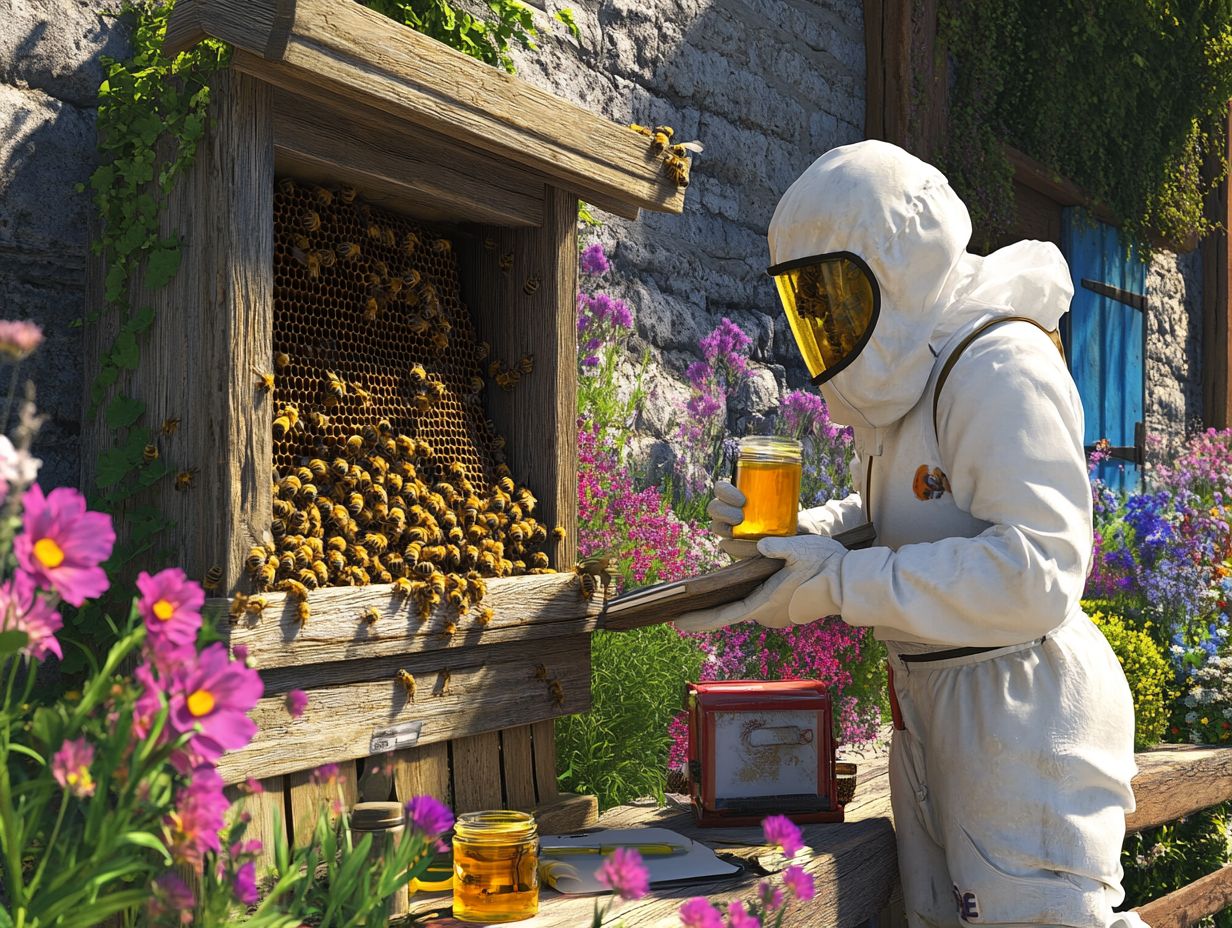
Monitoring nectar flow in your hives is crucial for ensuring that your colonies are thriving and have ample resources. Regular hive inspections allow you to evaluate conditions inside the hive and the availability of nectar stores. These inspections are vital for early detection of issues such as mite infestations and brood diseases.
Techniques like visual inspections, using a refractometer (a tool to measure nectar moisture content), and weighing the hive provide valuable insights into nectar flow and overall colony health. Additionally, monitoring queen cells and ensuring a proper nurse bee population are key to maintaining colony stability.
1. Visual Inspections
Visual inspections are an essential tool for beekeepers to monitor nectar flow within their hives. By closely observing bee behavior and assessing honey stores, you gain invaluable insights. Inspecting frames for capped honey, uncapped nectar, and the presence of brood lets you evaluate nectar availability and gauge colony health.
Regular checks help you pinpoint potential issues related to brood rearing, hive management, and varroa mites before they escalate.
These inspections reveal critical indicators, such as the presence of stored pollen, which is crucial for larval feeding. They also facilitate early detection of pests or diseases, including varroa mites and brood diseases, that might threaten colony stability.
By observing foraging patterns, you can determine if your bees are efficiently gathering resources or facing challenges due to environmental conditions. A well-timed visual inspection helps prevent disruptions during sensitive periods, like nectar flow shortages or insufficient brood patterns, ensuring your hive remains productive and healthy throughout the seasons. Additionally, incorporating honey supers at the right time can help manage excess nectar flow and prevent overcrowding.
2. Using a Refractometer
Using a refractometer is a precise way to monitor the moisture content of nectar and honey within the hive. By regularly checking the moisture content, you can better understand the nectar flow and make informed decisions about when to add honey supers for honey storage. Keeping the moisture content in check also prevents fermentation, which could otherwise compromise honey quality.
Using a refractometer is an excellent strategy for you as a beekeeper to monitor nectar flow by measuring the moisture content of the nectar your bees collect.
This handy tool enables you to determine the optimal moment for processing nectar into honey and ensure it meets the ideal moisture content for storage. By keeping an eye on moisture levels, you can guarantee that the honey produced is of the highest quality while minimizing the risk of fermentation, which ultimately enhances your hive management practices.
To effectively wield a refractometer, start by getting a small sample of nectar or honey and place a few drops onto the prism of the device. After securing the cover plate, peer through the eyepiece to observe the scale, making sure the light source is adequate for clear visibility. An ideal moisture content reading for honey typically falls between 17% and 20%. Reading above this range means you need to reduce the nectar’s moisture before storage.
Understanding moisture levels is crucial; too much moisture can lead to fermentation, adversely affecting both the quality and marketability of your honey.
By keeping a close eye on these measurements, you can refine your harvesting strategies and maximize honey production. Stay on top of your game to maximize your honey harvest!
3. Weighing the Hive
Weighing the hive is an excellent method for monitoring nectar flow, offering insights into the hive’s overall weight gain from nectar collection and honey storage. By regularly weighing your hive, you can track weight changes and gauge the effectiveness of nectar flow throughout the seasons. This proactive approach allows you to manage your hive more effectively, ensuring your bees have the necessary space and resources for optimal honey production.
To weigh your hive effectively, you ll want to invest in a digital scale made for beekeeping, which accurately measures the weight of your hive. Consistency is key; aim to take measurements at the same times each week so you can establish a clear trend over time.
When interpreting weight changes, it s crucial to understand how these fluctuations relate to seasonal shifts. Environmental conditions can also impact nectar availability. For example, a significant increase in weight might indicate a robust nectar flow, while a sudden drop could signal depletion or potential stress within the hive. This insight enables you to address any emerging issues promptly, keeping your bees healthy and productive.
How to Manage Nectar Flow in Hives?
Effectively managing nectar flow in your hives is crucial for maximizing honey production and maintaining the health of your colony, and it requires several proactive strategies.
You need to ensure there s ample space within the hive, optimize ventilation, and provide supplemental feeding when necessary to support your foraging bees.
By adding honey supers during peak nectar flow and rotating them appropriately, you can guarantee that your colonies have the capacity to store all the nectar they re gathering.
Act quickly to ensure your bees are thriving and your honey production is maximized!
Stay proactive and watch your hive flourish with your expert management!
1. Providing Adequate Space
Providing ample space within the hive is essential for managing nectar flow effectively. This allows your foraging bees to store their collected nectar with ease. When there are too many bees in one space or not enough honey storage boxes, their productivity can decline, influencing both honey production and the overall health of the colony.
As a beekeeper, regularly check the hive’s space and add additional boxes for honey storage as needed. This promotes optimal nectar storage and helps prevent swarming tendencies.
To determine if more space is necessary, keep an eye on your hive’s population and assess the amount of nectar being brought in during peak flow seasons. If frames fill up quickly and you see signs of congestion among the bees, it s a clear signal to expand their storage capacity.
Adding honey storage boxes at this critical moment enhances your hive’s productivity and lowers the risk of swarming. This behavior often arises from a sense of overcrowding. Ensuring your bees have ample room creates a thriving environment that benefits both the colony and your honey yield.
2. Making Sure the Hive is Well-Ventilated
Good ventilation in your hive is crucial for managing nectar flow. Proper airflow helps regulate temperature and humidity levels within the hive. This not only supports the health of your foraging bees but also aids in evaporating excess moisture from nectar, facilitating its transformation into honey.
Regularly monitor hive ventilation and make adjustments as needed. This creates a healthy space for your bees and the honey they make.
To improve ventilation, adjust the entrance sizes for optimal airflow while keeping pesky intruders at bay. Using screened bottom boards is another effective strategy; they improve ventilation and help monitor hive health by allowing natural debris to fall away.
Recognize that proper ventilation affects the efficiency of nectar transformation into honey. It also minimizes the risk of mold developing in the hive. With careful management, these steps create a supportive atmosphere that promotes better nectar flow and abundant honey production.
3. Adding Supers
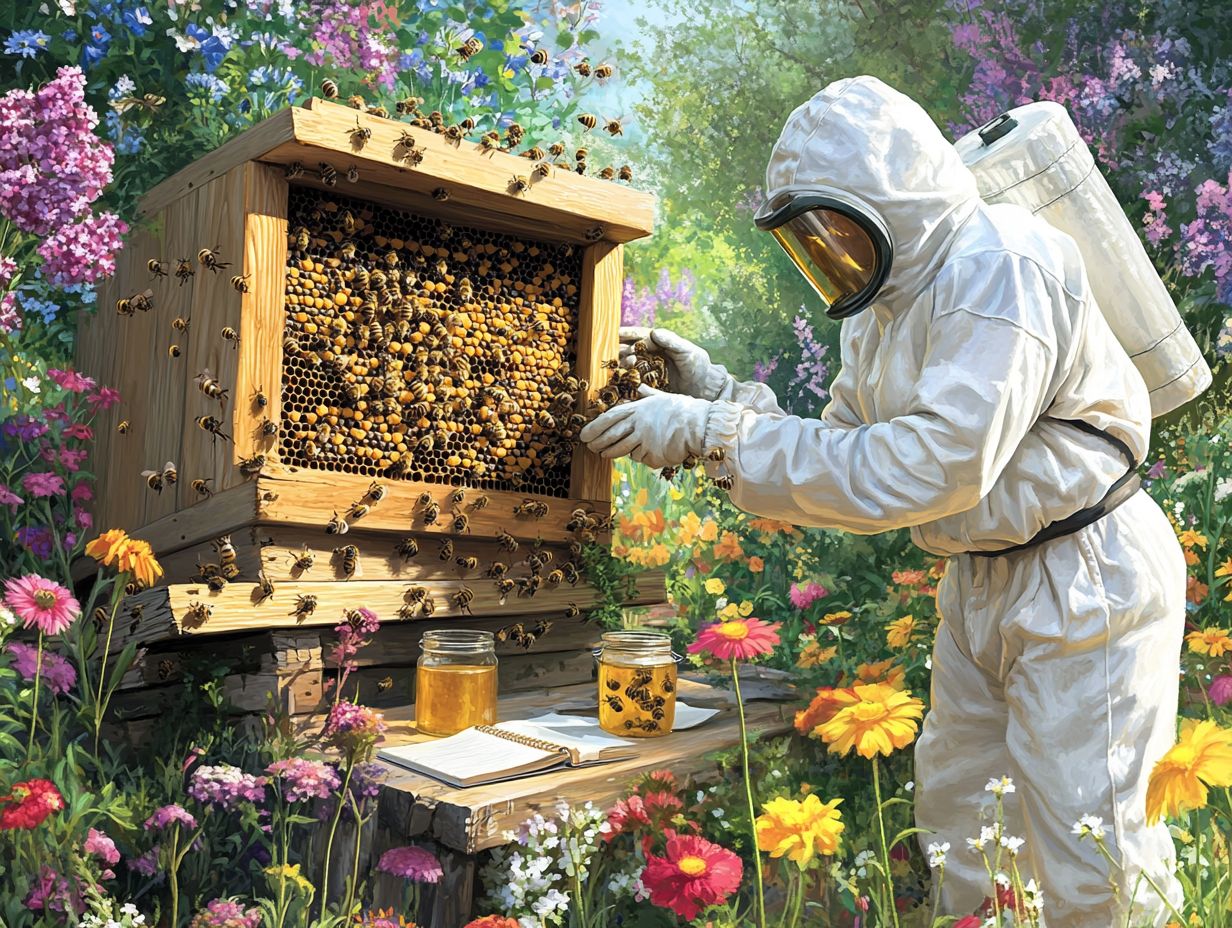
Adding honey storage boxes to your hive is essential for managing nectar flow and boosting honey production! This step provides extra space for your bees to store precious nectar and honey. When nectar flow is strong, promptly adding these boxes is crucial; it prevents overcrowding and supports the bees in their foraging activities. Monitor nectar flow closely to find the right time for adding these boxes and maximize your honey yields.
Place the new boxes above the brood chamber, as bees instinctively move upward to store their honey. Choose a clear day for this task; it ensures the bees are actively foraging and less likely to become agitated. Check the hive’s weight to see how well the bees are doing; a heavier hive usually means they re filling the existing boxes.
Inspect the frames for capped honey to guide your decision on which boxes need to be added. This helps maintain an organized and productive hive environment during the prime nectar flow.
4. Rotating Supers
Rotating honey storage boxes is a smart strategy for managing nectar flow. This ensures your bees have access to the freshest and most suitable storage space for their nectar. Regularly rotating boxes encourages more efficient nectar storage and discourages bees from abandoning older, less productive boxes. This practice optimizes honey production and supports the health and activity of the foraging bees in your hive.
Consider this rotation every few weeks during the active foraging season, depending on local conditions and nectar availability. By implementing this method, you significantly enhance your hive s productivity, as bees are more inclined to fill the newer boxes with honey.
Properly rotating boxes helps maintain a consistent nectar flow, reduces the risk of overcrowding, and prevents your bees from becoming overwhelmed by older, partially filled frames. Ultimately, this approach fosters a more organized and productive environment for your colony, leading to better honey yields and stronger overall health.
5. Planting Nectar-Rich Plants
Planting nectar-rich plants around your apiaries is an excellent strategy to enhance nectar flow. This ensures your foraging bees have plenty of resources while fostering healthier colonies. By increasing the availability of flowering plants, you can support your bees during peak nectar flow periods. This ultimately leads to a boost in honey production.
Choosing a diverse array of nectar-rich plants not only enriches their diet but also promotes resilience in your colonies. It ensures a steady food supply throughout different seasons.
For instance, as spring rolls in, consider planting flowering fruit trees like apple and cherry. These provide essential early-season nourishment for your bees. When summer approaches, embrace the vibrant blooms of lavender and sunflowers. Both of these offer valuable nectar sources during those warmer months.
As fall arrives, don t overlook blooms like asters and goldenrod. These will help sustain your bees as they prepare for the chill of winter.
Engaging in local ecological practices can tremendously enhance nectar availability. Create pollinator gardens or take part in habitat restoration projects. This collaborative effort contributes positively to your honey production and reinforces the overall health of the local ecosystem. It creates a win-win for both your bees and the environment.
What to Do if Nectar Flow is Low?
When nectar flow is low, act now to support your colonies and keep your hive thriving! Insufficient nectar can lead to food shortages for your bees, so every moment counts take action immediately!
Implement supplemental feeding strategies. Offer sugar syrup or pollen patties to sustain your foraging bees. This ensures that your colony remains robust during these challenging times. Also, consider how Varroa mites impact your bees and other pests that can stress your colonies.
Proper hive management during periods of low nectar flow is crucial. It helps prevent stress on your bees and supports ongoing brood rearing and overall colony strength. Integrated pest management practices can help mitigate issues with Varroa mites and other pests.
Start planting today to create a vibrant, buzzing habitat for your bees!
1. Supplementing with Sugar Syrup
Supplementing your bee diets with sugar syrup is an effective strategy for when flowers stop blooming. This approach provides the essential carbohydrates that bees need for energy and to maintain a healthy colony. Mix sugar with water to create a simple syrup. This syrup encourages foraging bees to stay active and supports your hive’s health. Keep a close eye on your colony! They are counting on you to meet their needs during periods of nectar dearth (when there’s a shortage of flower nectar). Also, think about the needs of adult worker bees, who play a crucial role in maintaining the hive.
Typically, a 1:1 ratio of sugar to water works well for spring feeding, while a thicker syrup at a 2:1 ratio is perfect for late summer or fall, when your bees need to stock up for winter. Ensure that you mix the syrup thoroughly and heat it lightly to dissolve the sugar completely; this makes it more appealing for the bees. Remember to also monitor the worker population as this can influence feeding needs.
Timing is everything! Offering sugar syrup during an extended dry spell can stimulate active brood rearing. This helps keep your colonies robust in preparation for future foraging opportunities. By consistently monitoring and providing sugar syrup, you not only bolster your bees’ energy levels but also enhance your hive management effectiveness. Additionally, consider the availability of pollen resources to further support hive health.
Start supplementing your bees today and watch your hive thrive!
2. Feeding Pollen Patties
Feeding pollen patties, a mixture that provides bees with the nutrients they need, is an important method for supporting your bee colonies during low nectar flow periods. These patties provide the needed protein for brood rearing and overall colony health. By ensuring that your nurse bees receive the nutrition they need, even when natural pollen sources are scarce, you can maintain the vitality of your hive.
Pollen patties can also help mitigate issues with brood diseases by ensuring proper nutrition. Positioning pollen patties strategically within the hives enhances the nutritional intake of your bees, helping to preserve the strength of your colony. This practice also supports egg-laying by the queen, ensuring a steady population of worker bees.
You can either purchase commercially prepared protein-rich patties or craft your own homemade versions with key ingredients like powdered pollen, sugar, and yeast. To maximize their effectiveness, keep an eye on your colony’s specific needs. Placing the patties near the brood nest will make them easily accessible for the nurse bees. Just be cautious about overfeeding, as excess can lead to waste and even harm the hive.
Properly managed, pollen patties can support the development of winter bees as well. By supplementing their diet during times of limited natural pollen availability, you can effectively boost brood rearing and ensure the long-term viability of your colonies. This contributes to robust and effective hive management and is essential for maintaining a healthy colony lifecycle.
3. Moving the Hive to a Different Location
If you find that nectar flow is consistently low in a particular area, relocating your hive to a spot with more abundant floral resources can greatly benefit your bees. A well-planned move allows your foraging bees to access new nectar sources, enhancing honey production and overall colony health. It’s crucial to assess potential new locations carefully to ensure they meet the needs of your bees.
Consider moving your hive to an area that supports queen rearing and has diverse pollen resources. When considering a new spot, seek out areas rich in diverse flowering plants and various tree species that bloom at different times. This diversity can provide a continuous nectar supply throughout the foraging season.
Make sure to evaluate the landscape for vital factors such as water availability, sunlight exposure, and wind protection. All of these can significantly impact bee activity and hive performance. By observing the local flora and reviewing past honey yields, you can gain valuable insights into the area’s productivity.
Strategically moving your hives can lead to improved nectar flow, promoting healthier colonies and boosting honey yields. This adaptability underscores the importance of thoughtful management in beekeeping. Always consider the seasonal patterns that affect nectar flow and honey production.
Frequently Asked Questions
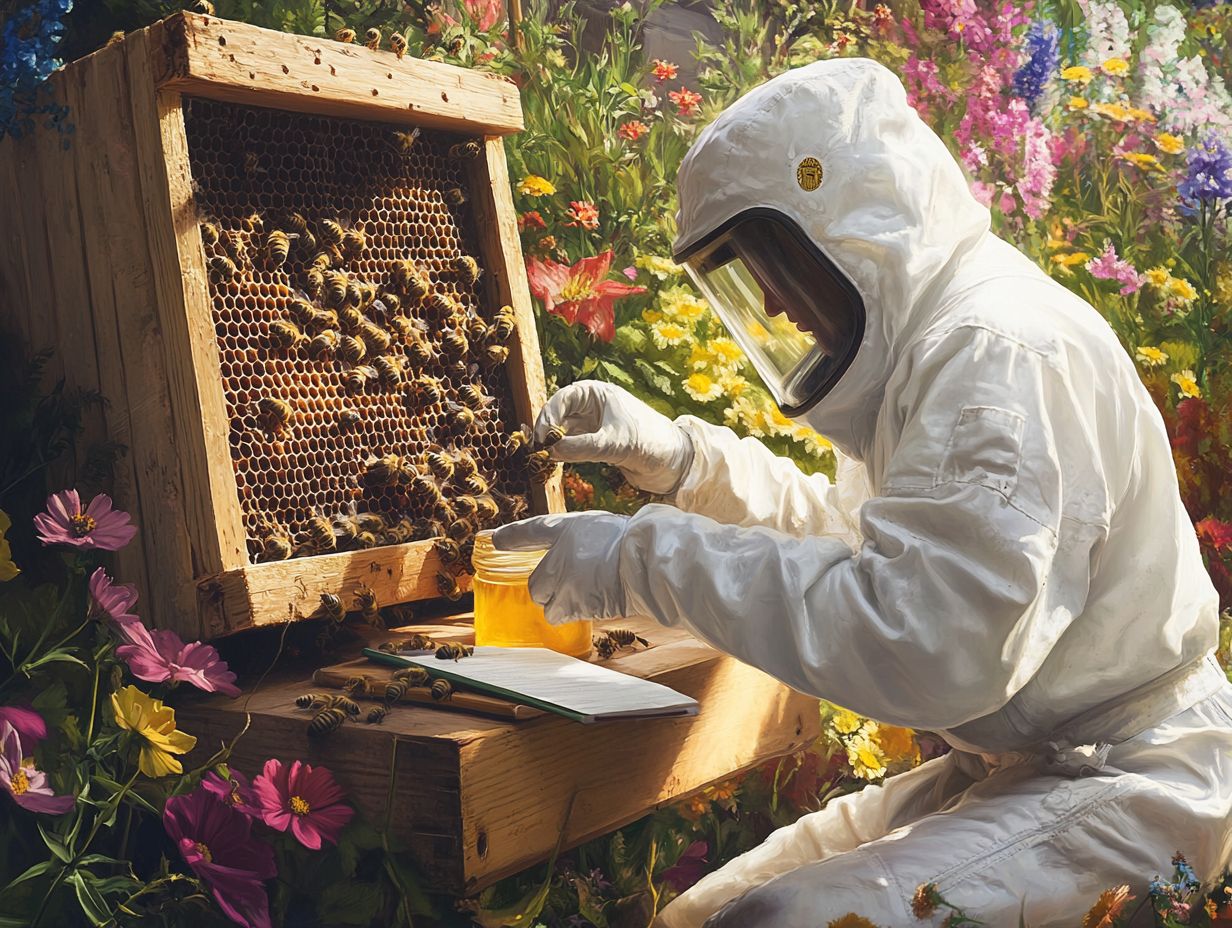
What is nectar flow and why is it important to manage?
Nectar flow is the period when flowers are blooming and producing nectar, which is the main food source for honey bees. Managing nectar flow in hives is important because it affects the bees’ ability to produce honey and maintain a healthy colony. Effective colony management requires understanding nectar flow and seasonal patterns.
How can I tell if there is a nectar flow happening?
You can tell if there is a nectar flow by observing your bees. During a nectar flow, bees will be seen flying in and out of the hive with full pollen baskets. You may notice an increase in bee activity around your garden or nearby fields. Strong nectar flow can quickly fill honey supers.
What are some ways to manage nectar flow in hives?
One way to manage nectar flow is ensuring that your hive has enough space for the bees to store honey. You can also plant nectar-rich flowers in your garden to provide a continuous food supply for your bees. Adding a honey super to your hive encourages the bees to produce more honey. Regular hive inspections can help you stay on top of nectar flow and storage needs.
Remember, timely action in managing your bees can lead to thriving colonies and bountiful honey harvests!
How Does Weather Affect Nectar Flow in Hives?
Weather plays a crucial role in nectar flow as it determines the availability of nectar-producing flowers. Rainy or cold weather can slow down or even stop nectar flow, while warm and sunny weather can stimulate it. It is important to keep track of weather patterns when managing nectar flow. Also, consider the impact of weather on swarm behavior.
What Should I Do If There Is a Shortage of Nectar Flow?
If there is a shortage of nectar flow, you can supplement your bees’ diet by providing them with sugar syrup or a pollen substitute. You can also move your hives to a different location with a better nectar flow. It is important to regularly monitor your hives and take necessary actions to ensure the bees have enough food. Be prepared for seasonal behavior changes and adjust your management practices accordingly.
Can Too Much Nectar Flow Be Harmful to Bees?
While a strong nectar flow is crucial for honey production, too much of it can be harmful to bees. Overcrowding in the hive can lead to competition for resources and can result in swarming. It is important to manage nectar flow to maintain a balance in the hive and prevent negative effects on the colony. Also, consider the queen pheromone levels, which can affect the colony’s swarming tendencies.

